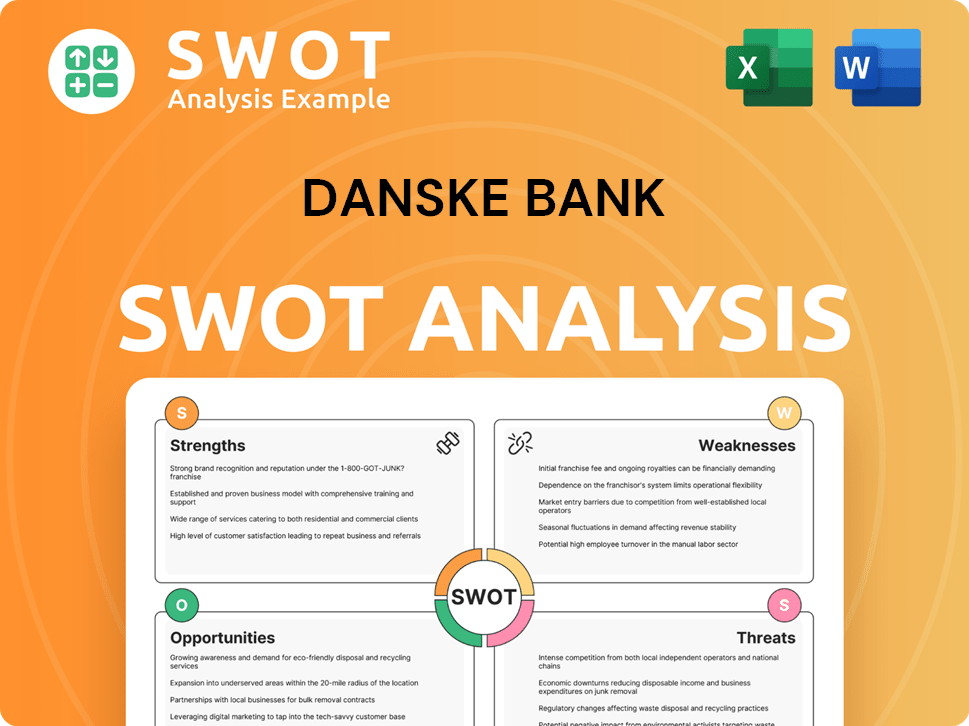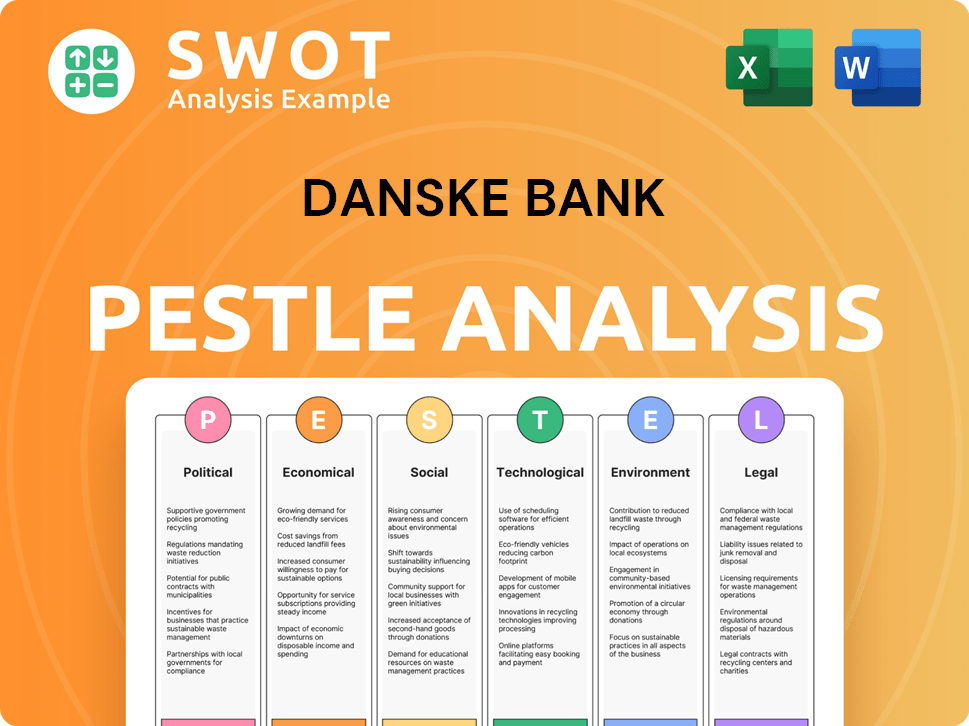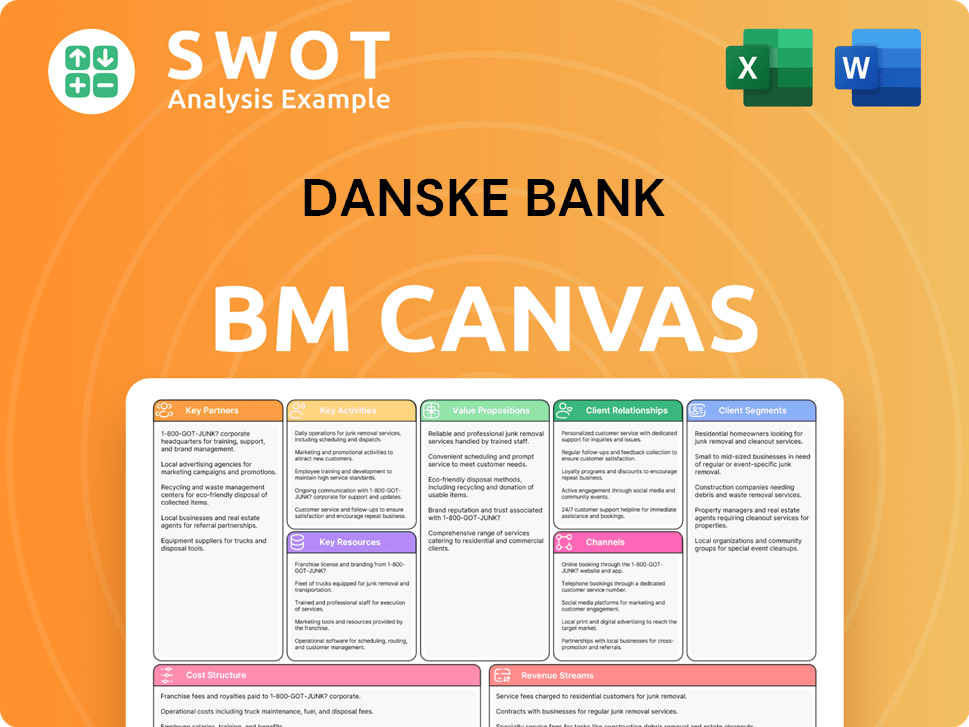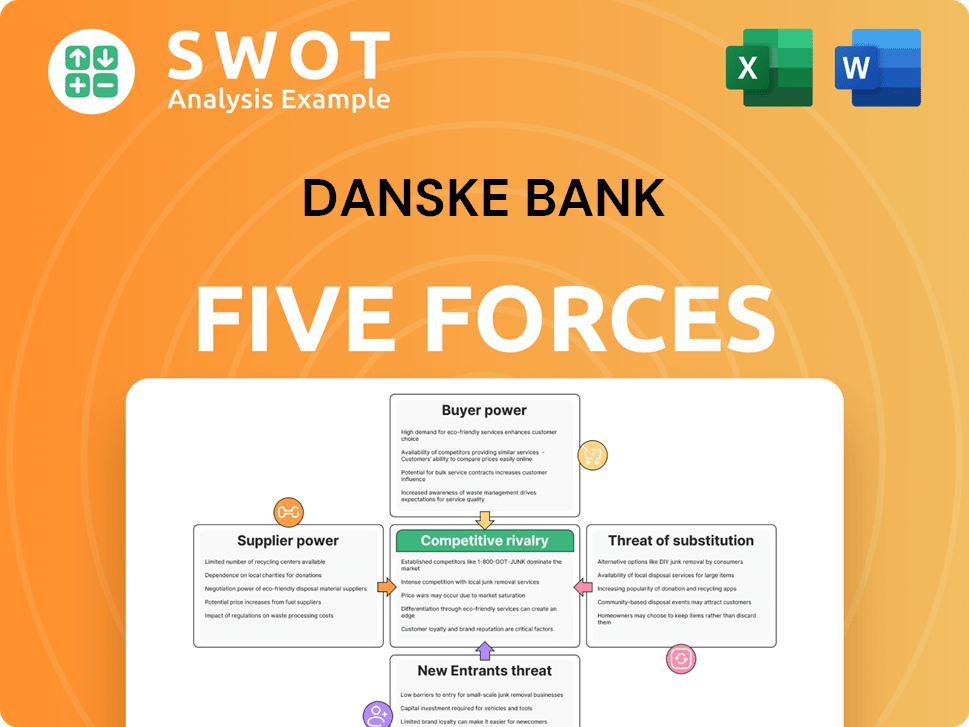Danske Bank Bundle
Who Does Danske Bank Serve? Unveiling Its Customer Base.
In today's dynamic financial landscape, understanding customer demographics is crucial for any bank's success. Danske Bank, a leading Nordic banking group, has adapted to evolving customer expectations, especially with the rise of digital banking. Recognizing the importance of this shift, Danske Bank launched a new 'Become a customer' app in late 2024, highlighting its commitment to serving a digitally-savvy clientele.

This exploration delves into Danske Bank's Danske Bank SWOT Analysis, customer demographics, and target market strategies. We'll examine its customer segmentation, including the Danske Bank customer profile, geographical presence, and the diverse needs of its clientele across the Nordic region and Northern Ireland. Analyzing the Danske Bank customer age range, income levels, and customer service preferences provides valuable insights for investors and business strategists alike, offering a comprehensive Danske Bank market analysis.
Who Are Danske Bank’s Main Customers?
Understanding the customer demographics and target market of Danske Bank is crucial for grasping its strategic direction. The bank segments its customer base into Personal Customers, Business Customers, and Large Corporates & Institutions. This segmentation allows for tailored services and focused marketing efforts, reflecting a deep understanding of diverse financial needs.
Danske Bank's strategic shifts, such as divesting its personal customer business in Norway in 2024, highlight its commitment to optimizing its market presence. This focus allows the bank to leverage its strengths in specific segments. The bank's approach to its target market is dynamic, adapting to market conditions and customer needs to maintain a competitive edge.
The bank's customer profile is shaped by its strategic focus and market positioning. The bank's customer segmentation strategy is designed to maximize its impact and efficiency in the financial sector. Danske Bank's ability to adapt and refine its customer focus is key to its long-term success.
For personal customers, Danske Bank aims to be the leading bank in Denmark and expand in Finland and Sweden. In Sweden and Finland, the bank targets the mass-affluent and private banking segments. This focus suggests a Danske Bank customer profile with higher income levels, seeking sophisticated financial solutions.
Danske Bank targets small and medium-sized businesses (SMEs) across the Nordic markets. In the first quarter of 2025, the bank expanded its customer base in the mid-sized segment. The bank aims to be the leading Nordic bank for business and corporate customers. This segment is crucial for driving economic growth.
This segment focuses on providing strategic advice and financial solutions to large Nordic and institutional customers. In 2024, Danske Bank regained its position as the Nordic bank with the highest customer satisfaction among corporate and institutional clients. This segment is vital for large-scale financial transactions.
Danske Bank actively engages with customers in high-impact sectors like agriculture and large corporates in industries such as energy, food, and transportation. This focus includes addressing sustainability transitions. The bank's engagement in these sectors reflects its commitment to sustainable finance.
Danske Bank's customer segmentation strategy is designed to optimize its market presence and leverage its strengths. The bank's commitment to customer satisfaction is evident in its high ratings among corporate clients. The bank's strategic focus on key sectors highlights its commitment to sustainable finance and economic growth.
- Danske Bank's strategic shift in Norway reflects a focus on business and corporate clients.
- The bank aims to be a leader in the Nordic region for both business and corporate customers.
- Danske Bank's focus on sustainability transitions in key sectors is a strategic priority.
- The bank's customer satisfaction scores indicate strong engagement and service quality.
Danske Bank SWOT Analysis
- Complete SWOT Breakdown
- Fully Customizable
- Editable in Excel & Word
- Professional Formatting
- Investor-Ready Format

What Do Danske Bank’s Customers Want?
Understanding customer needs and preferences is central to the strategy of Danske Bank. The bank's 'Forward '28' strategy is heavily invested in enhancing customer experience through digital platforms, expert advice, and sustainability initiatives. This approach reflects a deep understanding of how customer expectations are evolving in a digital financial landscape.
Customers are increasingly prioritizing convenience and accessibility. Danske Bank addresses this through digital solutions, such as the 'Become a customer' app launched in late 2024, which facilitates entirely digital onboarding. The bank also focuses on simplifying and making offerings more flexible to meet individual needs, enhancing digital self-service tools, and exploring new investment services.
The bank recognizes the importance of effective communication, professionalism, and helpful advice from its staff, while also addressing customer concerns about service delays. For business customers, the focus is on efficient daily banking and expert advice, with investments in digital solutions and advisory services to provide strategic insights. The bank's success in meeting these needs is highlighted by its strong performance in customer satisfaction surveys among corporate and institutional clients in 2024.
The 'Become a customer' app, launched in late 2024, allows for quick and entirely digital onboarding. This is a key feature for attracting new customers and streamlining the initial banking experience.
Simplifying offerings and making them more flexible to cater to individual needs. This includes enhancing digital self-service tools for mortgages and exploring new investment services.
Business customers, including small and medium-sized businesses and large corporates, prioritize efficient daily banking and expert advice. This includes convenient digital solutions and advisory services.
A growing preference for sustainable finance is evident, with Danske Bank actively supporting customers' sustainability transitions through ESG advisory services and innovative product offerings.
Danske Bank's strong performance in customer satisfaction surveys among corporate and institutional clients in 2024 highlights its success in meeting these needs.
The bank's focus on supporting customers in high-emitting sectors with their climate transition strategies demonstrates its responsiveness to a significant and emerging customer need.
Danske Bank's approach to understanding its Owners & Shareholders of Danske Bank involves a deep dive into customer preferences. This includes a focus on digital convenience, personalized services, and sustainable finance options. The bank's strategy is tailored to meet the evolving needs of its diverse customer base.
- Digital Accessibility: Customers want easy-to-use digital platforms and mobile banking solutions.
- Personalized Services: Tailored financial products and advice that meet individual needs.
- Expert Advice: Professional and helpful guidance from bank staff.
- Sustainability: Support for sustainable finance and ESG initiatives.
- Efficient Banking: Streamlined processes for daily banking activities, especially for business clients.
Danske Bank PESTLE Analysis
- Covers All 6 PESTLE Categories
- No Research Needed – Save Hours of Work
- Built by Experts, Trusted by Consultants
- Instant Download, Ready to Use
- 100% Editable, Fully Customizable

Where does Danske Bank operate?
The geographical market presence of Danske Bank is primarily concentrated in the Nordic region, including Denmark, Norway, Sweden, and Finland, alongside a presence in Northern Ireland and other parts of the United Kingdom. This strategic focus allows the bank to leverage its established brand and expertise within these key markets. Understanding the Growth Strategy of Danske Bank is crucial for grasping its market approach.
Denmark serves as Danske Bank's largest market, where it holds a leading position. The bank's focus on these areas reflects its commitment to maintaining a strong presence and adapting to local market dynamics. This includes both retail and business banking services, tailored to meet the specific needs of each region.
In the first quarter of 2025, the housing market in Denmark showed consistent growth, indicating a stable environment for personal banking customers. This suggests a positive outlook for the bank's operations in its largest market. The bank's strategic decisions are influenced by the economic conditions and market trends within each of these regions.
Danske Bank holds a leading market position in Denmark. In 2021, the bank had a market share of approximately 25% in lending and 29% in deposits. The consistent growth in the housing market in Q1 2025 further solidifies its strong position.
In Finland, Danske Bank maintains a strong presence, with an 11% market share. The housing market in Finland also showed signs of recovery in Q1 2025, indicating a stable environment for banking services.
Sweden is considered a 'challenger market' for Danske Bank, with an 8% market share. The bank focuses on the mass-affluent and private banking segments in Sweden, aiming to increase its market share.
Danske Bank decided to exit its Personal Customers business in Norway by the end of 2024. The bank is reallocating resources to expand its Business Customers and Large Corporates & Institutions segments.
In Northern Ireland, Danske Bank serves personal, business, and corporate customers. The Business Customers unit in Northern Ireland saw a 32% increase in profit in Q1 2025. The bank has been active in engaging with over 300 agriculture sector customers and more than 50 large corporates across high-impact industries by the end of 2024.
- The bank aims to engage with 30 key global investee companies by 2025 to help them set and report on nature impact targets.
- This strategic focus highlights Danske Bank's commitment to sustainability and responsible banking practices.
- The bank's focus on specific customer segments allows for targeted marketing and service offerings.
- Danske Bank's customer demographics across these regions vary, influencing its market strategies.
Danske Bank Business Model Canvas
- Complete 9-Block Business Model Canvas
- Effortlessly Communicate Your Business Strategy
- Investor-Ready BMC Format
- 100% Editable and Customizable
- Clear and Structured Layout

How Does Danske Bank Win & Keep Customers?
Danske Bank's approach to customer acquisition and retention is deeply rooted in digital transformation, customer-centricity, and sustainability, guided by its 'Forward '28' strategy. The bank focuses on enhancing the customer experience and building loyalty through digital platforms, expert advice, and tailored solutions. This strategy is supported by leveraging customer data and segmentation to target campaigns effectively, especially within key markets like Sweden and Finland.
The bank's commitment to providing expert advice and tailored solutions, particularly for complex financial needs, is a core retention driver. They are also integrating sustainability into customer engagement through new ESG advisory services and strategic partnerships. This dual focus on digital innovation and personalized service aims to attract and retain a diverse customer base, aligning with evolving customer values and preferences.
As of late 2024, the launch of the 'Become a customer' app is a key initiative for customer acquisition. This app provides a fully digital onboarding process, especially targeting younger demographics who favor digital solutions. The bank also plans to release a new version of its District online banking platform for small businesses in Denmark in the first half of 2025, which will further enhance digital acquisition channels.
The 'Become a customer' app, launched in late 2024, allows a fully digital onboarding process, making it easier for new customers to join. This is particularly effective in attracting younger customers who prefer digital solutions. The upcoming launch of the District online banking platform in the first half of 2025 will further boost acquisition.
Danske Bank is investing in digital platforms to deliver market-leading convenience and personalization. This includes features that increase proactivity and easy access to assistance and advice. Customer satisfaction scores for mobile banking services and advisory offerings have improved.
The bank focuses on providing expert advice and tailored solutions to meet complex financial needs. They have improved digital self-service tools for mortgages and are exploring enhanced investment services. This personalized approach is a key factor in customer retention.
Danske Bank uses customer data and segmentation to target campaigns effectively. This includes a focus on specific segments like mass-affluent and private banking customers in Sweden and Finland. This targeted approach helps to optimize marketing efforts and improve customer engagement.
Sustainability is integrated into customer engagement through new ESG advisory services and strategic partnerships. The bank engaged with over 300 agriculture sector customers and more than 50 large corporates by the end of 2024 to discuss biodiversity impacts and develop sector-specific strategies. This approach supports customers' sustainability transitions and enhances retention.
- New ESG advisory services are offered to help customers with their sustainability goals.
- Strategic partnerships are formed to support customers in their sustainability transitions.
- The bank is actively engaging with key sectors to develop tailored sustainability strategies.
Danske Bank Porter's Five Forces Analysis
- Covers All 5 Competitive Forces in Detail
- Structured for Consultants, Students, and Founders
- 100% Editable in Microsoft Word & Excel
- Instant Digital Download – Use Immediately
- Compatible with Mac & PC – Fully Unlocked

Related Blogs
- What are Mission Vision & Core Values of Danske Bank Company?
- What is Competitive Landscape of Danske Bank Company?
- What is Growth Strategy and Future Prospects of Danske Bank Company?
- How Does Danske Bank Company Work?
- What is Sales and Marketing Strategy of Danske Bank Company?
- What is Brief History of Danske Bank Company?
- Who Owns Danske Bank Company?
Disclaimer
All information, articles, and product details provided on this website are for general informational and educational purposes only. We do not claim any ownership over, nor do we intend to infringe upon, any trademarks, copyrights, logos, brand names, or other intellectual property mentioned or depicted on this site. Such intellectual property remains the property of its respective owners, and any references here are made solely for identification or informational purposes, without implying any affiliation, endorsement, or partnership.
We make no representations or warranties, express or implied, regarding the accuracy, completeness, or suitability of any content or products presented. Nothing on this website should be construed as legal, tax, investment, financial, medical, or other professional advice. In addition, no part of this site—including articles or product references—constitutes a solicitation, recommendation, endorsement, advertisement, or offer to buy or sell any securities, franchises, or other financial instruments, particularly in jurisdictions where such activity would be unlawful.
All content is of a general nature and may not address the specific circumstances of any individual or entity. It is not a substitute for professional advice or services. Any actions you take based on the information provided here are strictly at your own risk. You accept full responsibility for any decisions or outcomes arising from your use of this website and agree to release us from any liability in connection with your use of, or reliance upon, the content or products found herein.